AMD Radeon RX 6700 XT Review
A new 1440p graphics card with ray tracing skills
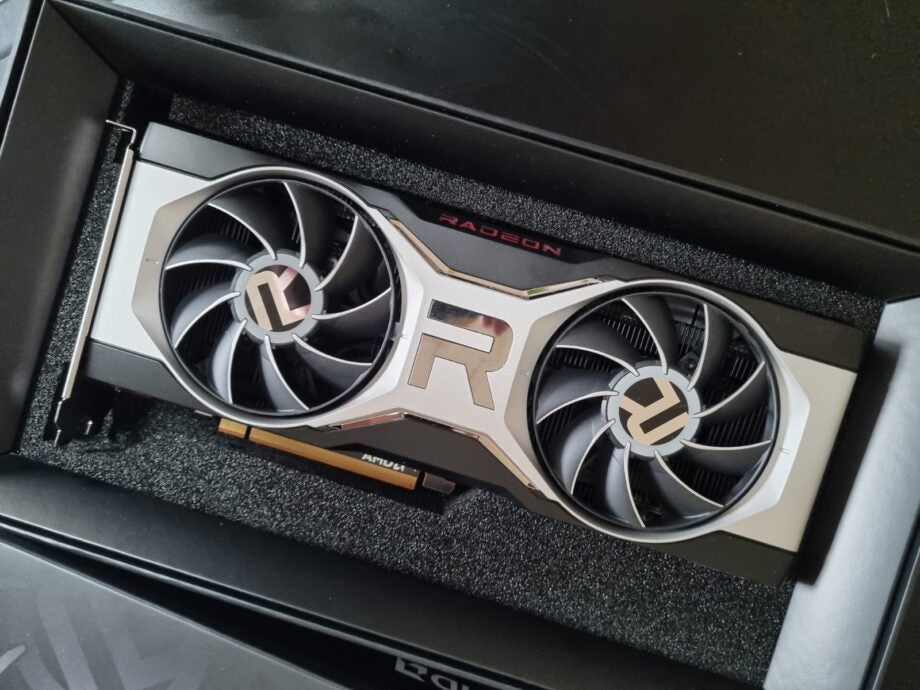

Verdict
The AMD Radeon RX 6700 XT is a solid performer if you want a GPU for 1440p or 1080p gaming, delivering post-60fps speeds (with ray tracing light effects turned off) throughout most of our tests. But AMD’s ongoing lack of a rival to Nvidia’s DLSS means it can’t compete when it comes to ray tracing performance right now, although this may change in the near-future.
Pros
- Solid 1440p performance
- Small twin-fan design makes it suitable for smaller builds
- Power-efficient, with reasonable headroom for overclocking
Cons
- Ray tracing performance limited to 1080p resolutions
- Lack of DLSS puts it behind Nvidia rivals for ray tracing
Key Specifications
- Review Price: £419.99
- Core clock speed: 2424MHz
- Boost clock speed: 2581MHz
- VRAM: 12GB GDDR6
- RDNA 2 compute units: 40
- Infinity Cache: 96MB
- TDP: 230W
The AMD Radeon RX 6700 XT is AMD’s latest attempt to create the ultimate ‘next-generation’ GPU for 1440p gaming.
This makes it one of the cheapest AMD cards to run using the firm’s latest RDNA 2 “Big Navi” architecture, sitting below the more premium RX 6800 and astronomically expensive RX 6900 XT.
The price makes it a pretty enticing proposition for PC gamers yet to jump to 4K. It also undercuts the ruling Nvidia RTX 3070, which remains one of the best GPUs for 1440p gaming, scoring a rare 5/5 when I tested it last year.
But, as I discovered when testing the other RX-line GPUs, while it delivers in most ways, the 6700 XT struggles in one key area: ray tracing light effects. This makes it difficult to wholeheartedly recommend to hardcore gamers that care about next-generation features right now – although that may change in the future. Here’s why.
Design and specs – Impressive, but missing a key ingredient
- The AMD Radeon RX 6700 XT is designed to play games at 1440p
- It has the same RDNA 2 architecture as the other RX cards
- It supports ray tracing, but AMD still hasn’t launched a DLSS rival
The AMD Radeon RX 6700 XT is smaller than I expected, featuring a twin-fan cooler, plus an eight- and six-pin power connector. Round the back you’ll find a single HDMI port and three display ports.
The 6700 XT is the smallest GPU in AMD’s current line and a better fit for ATX-mini-sized builds than most of AMD’s more expensive RDNA 2 cards, which feature longer three-fan designs.
Under the hood, the The 6700 XT features the same set of perks as its more expensive siblings, however. The highlight is RDNA 2. This is AMD’s latest GPU architecture and the first to add key features such as ray tracing to the mix. Ray tracing is a graphical technology that let GPUs render light more realistically, adding real-time reflections and shadows, for example. Prior to RDNA 2, the tech was exclusive to PC gamers with Nvidia RTX cards.
Comparing the exact performance between Nvidia and AMD ray tracing is a little tricky, since the two families use different architectures and solutions to make the feature work. Specifically, AMD does it by loading dedicated ray tracing accelerators to its cards, while Nvidia powers it with custom RT cores.
AMD claims its solution has a lead because RDNA 2 is also on the current generation PS5 and Xbox Series X/S consoles, which will give developers an incentive to use its Fidelity X suite of tools and to optimise titles for its platform. Although this claim hasn’t seen much evidence recently as, outside of a few Nvidia exclusives that run ray tracing in atypical ways (such as Quake II RTX and Wolfenstein Youngblood), most games with the feature work on both.
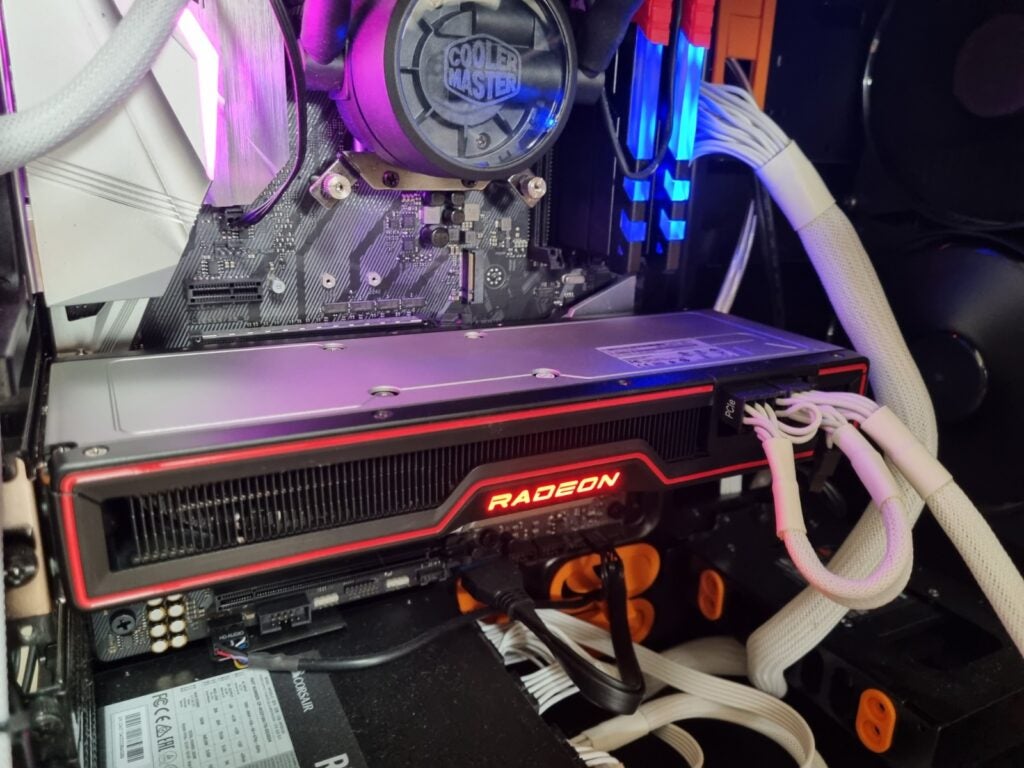
The other big perk for RX cards is their custom Infinity Cache and Smart Access Memory. Infinity Cache aims to boost performance by storing more of the data required for ray tracing locally to the GPU, removing the need to reload it each time. In my experience, the tech does lead to performance improvements and is a key reason the RX cards require less power to run than their AMD rivals.
The only downside is that, while present on the RX 6700 XT, the cheaper card only stores 96MB in Infinity Cache. The more expensive cards have a 128MB cap, so the RX 6700 won’t be as impressive in this field.
Smart Access Memory is a feature designed to improve how AMD RX GPUs and Ryzen 5000-family CPUs work together to further boost overall performance and power efficiency. At the time of review, I wasn’t able to test the feature since lockdown restrictions meant I didn’t have access to a Ryzen-compatible motherboard. I’ll update this review when I manage to source one.
The only serious downside with the RX 6700 XT is that, despite promising one for some time now, AMD still hasn’t set a firm release date for its FidelityFX Super Resolution tech. This is AMD’s answer to Nvidia’s DLSS – an AI technology that radically reduces the workload on a GPU while gaming with ray tracing on.
Without a solution such as DLSS, even modern GPUs struggle to play games at high resolutions with ray tracing on. This was a key reason previous RX cards failed to match Nvidia rivals when I tested them last year. To make matters worse, despite repeated requests for a timeline of FidelityFX Super Resolution’s release during briefings attended by Trusted Reviews, AMD still hasn’t given a firm release window for it. This leaves me slightly nervous about when the tech will arrive – and is likely to be a key sticking point for people who want to enjoy the benefits of ray tracing straight away.
Aside from this, the RX 6700 XT’s specs reflect its place in AMD’s line, featuring less memory and compute units than its siblings. You can see a full breakdown of its specs and how they compare to the competition in the table below.
| Card | Price | VRAM | Core Clock Speed | Boost clock speed | Tensor Cores | RT Cores | RDNA 2 compute units | Infinity cache | TDP |
| Nvidia RTX 3090 | $1499 | 24GB GDDR6x | 1395MHz | 1695MHz | 328 | 82 | NA | NA | 350W |
| AMD RX 6900 XT | $999 | 16GB GDDR6 | 1825MHz | 2250MHz | NA | NA | 80 | 128MB | 300W |
| Nvidia RTX 3080 | $699 | 10GB GDDR6x | 1440MHz | 1710MHz | 272 | 68 | NA | NA | 320W |
| AMD RX 6080 XT | $649 | 16GB GDDR6 | 1825MHz | 2250MHz | NA | NA | 72 | 128MB | 300W |
| Nvidia RX 3070 | $499 | 8GB GDDR6 | 1500MHz | 1730MHz | 184 | 46 | NA | NA | 220W |
| AMD RX 6800 | $579 | 16GB GDDR6 | 1700MHz | 2105MHz | NA | NA | 60 | 128MB | 250W |
| AMD RX 6700 XT | $479 | 12GB GDDR6 | 2424MHz | 2581MHz | NA | NA | 40 | 96MB | 230W |
| Nvidia RTX 3060 Ti | $399 | 8GB GDDR6 | 1410MHz | 1665MHz | 152 | 38 | NA | NA | 200W |
Performance and benchmarks – Solid, if you turn ray tracing off
- Can comfortably hit a 60fps performance in both 1080p and 1440p
- Struggles to hit 1440p when ray tracing is activated
- Low power draw compared to other RDNA 2 GPUs
To test the RX 6700 XT graphics card, I ran it through a variety of synthetic benchmarks and in-game tests using a rig with the below specs.
Test rig specs:
- Asus ROG Strix Z370-E Gaming (LGA1151)
- Intel Core i9-9900KF
- 16GB DDR4 RAM
- Samsung SSD 860 EVO 500GB SATA SSD
- Corsair RM750X PSU
- MasterLiquid Pro 280 cooler
Each test saw the games run with graphical settings maxed out in 1080p, 1440p and 4K resolutions. On titles without built-in benchmarks, we recorded the average frames-per-second they ran at while running through pre-selected sections of the game.
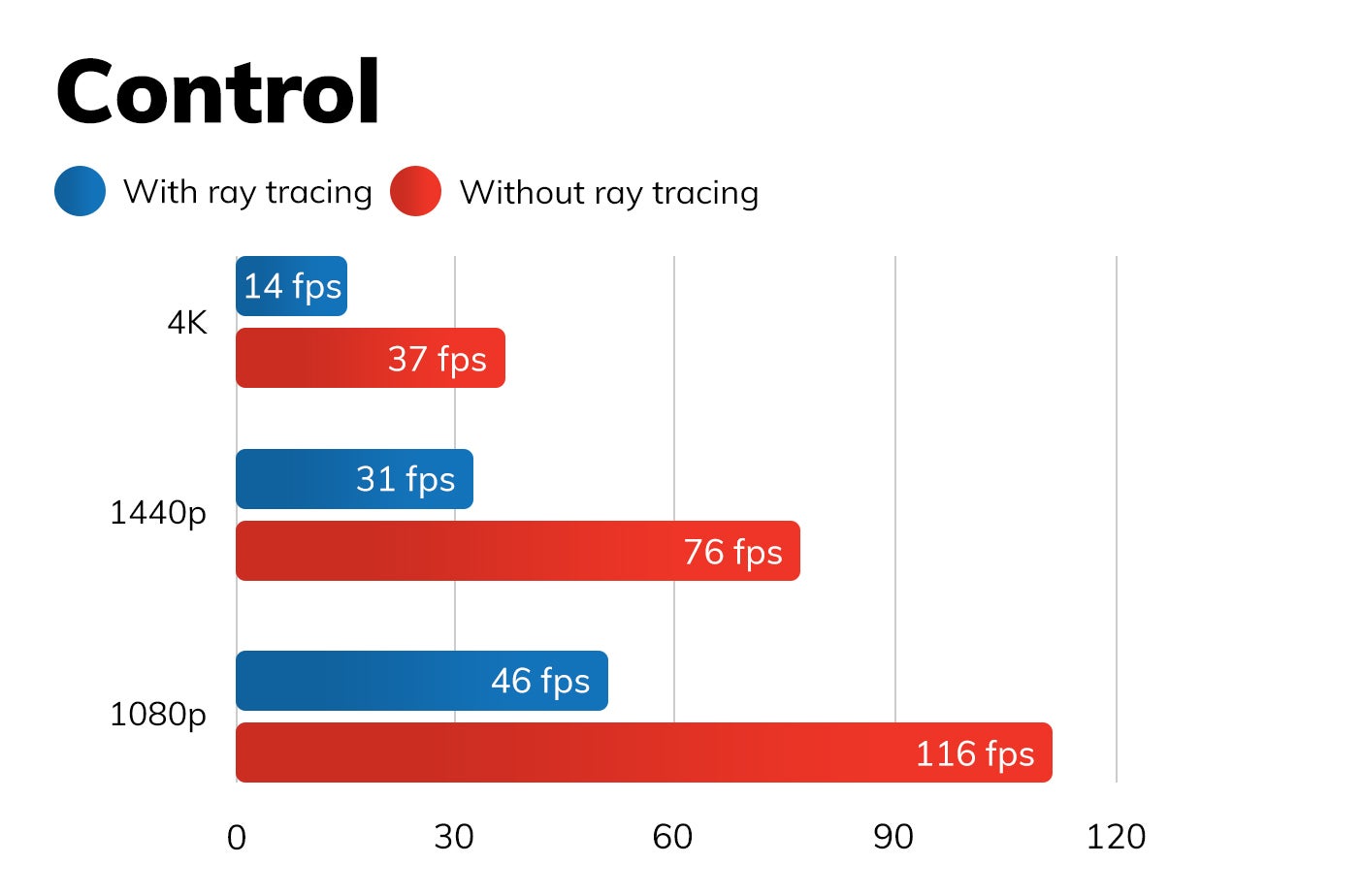
Control
Control is one of the best examples of ray tracing. It’s a beautiful game full of advanced physics, complex lighting effects and busy combat scenes. It doesn’t have an internal benchmark, so we gauge performance by recording the average frame rate during a set section of the game. We ran the test with the graphics maxed at various resolutions with ray tracing on and off.
Here, we found AMD’s graphics card to be capable of playing the game at 1080p and 1440p when ray tracing was turned off. With ray tracing on, frame rates saw a concerning drop. The lack of a DLSS rival showed it can only ran the game at consistently playable frame rates in 1080p.
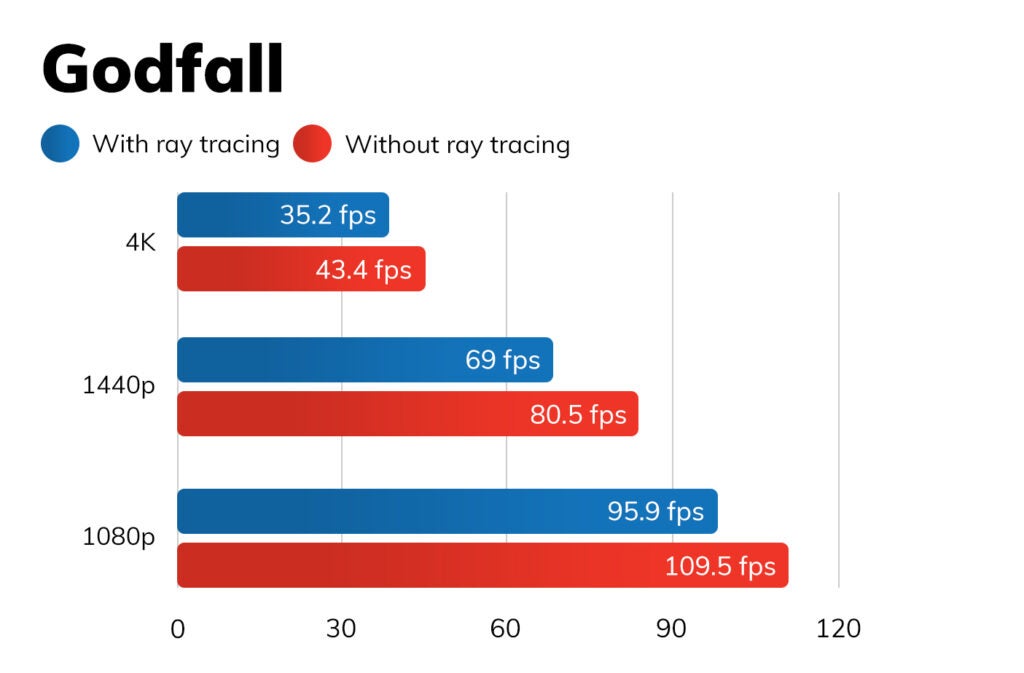
Godfall
Godfall is one of the first titles optimised for AMD RX cards with ray tracing. Despite being a very generic game to play, graphically it’s beautiful, featuring large-scale epic environments full of multiple NPCs and complex lighting effects.
It has an internal benchmark that we used to test performance across multiple resolutions, with ray tracing on and off. The RX 6700 XT offered excellent frame rates across every resolution with ray tracing off. It also exceeded the 60fps milestone with the feature on in 1440p and 1080p.
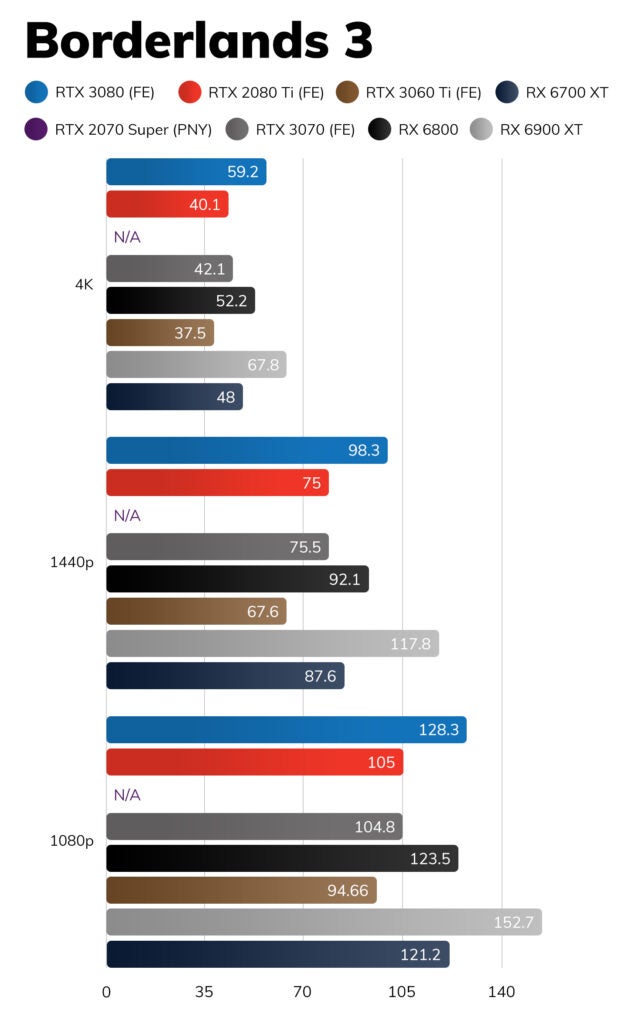
(Frame per second)
Borderlands 3
Borderlands 3 is a giant, power-intensive AAA shooter that really puts a GPU through its paces, despite not offering ray tracing support. It’s a good gauge to judge how a GPU will deal with power-hungry blockbuster titles.
It has an internal benchmark, which simulates a series of demanding in-game scenarios including large battles and busy city scenes full of moving NPCs and demanding explosion effects. Here, the RX 6700 XT delivered playable frame rates across the board, even outperforming the RTX 3070 in 4K. However, it still fell short of hitting 60fps at this resolution.
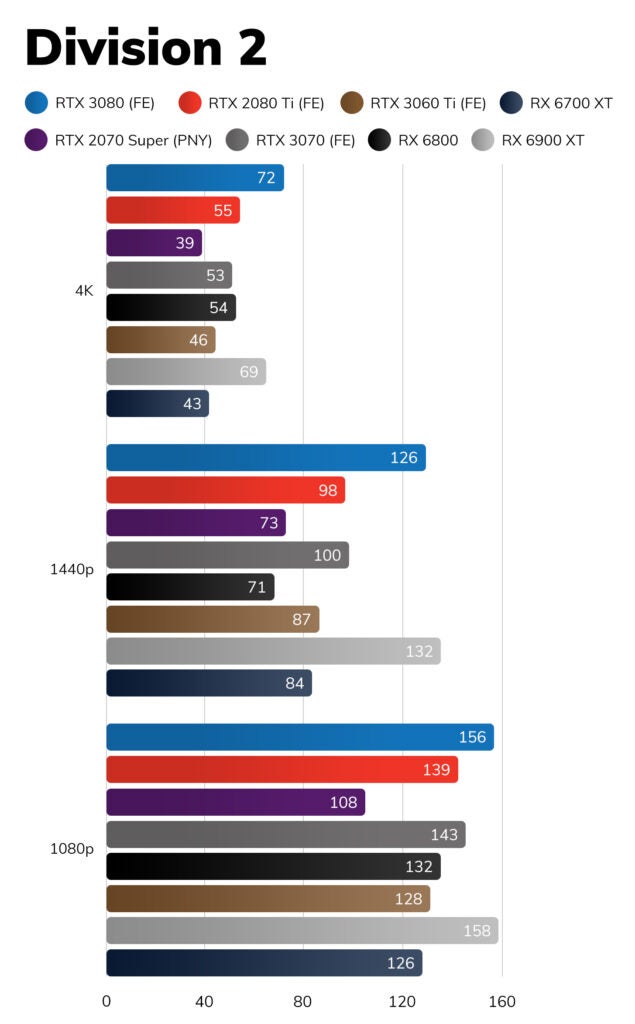
(Frame per second)
The Division 2
The Division 2 is one of Ubisoft’s largest, and most popular, live service games. It’s a massive-multiplayer tactical shooter set in a sprawling dystopian Washington DC. The game isn’t the most graphically demanding on the market, but its internal benchmark offers a solid means to gauge how a GPU will handle live service games as a genre.
Running its internal benchmark, which simulates a series of large, open-map battles and various city environments, the RX 6700 XT delivered playable frame rates in every resolution. But it only achieved the sought-after post-60fps speeds in 1440p and 1080p.
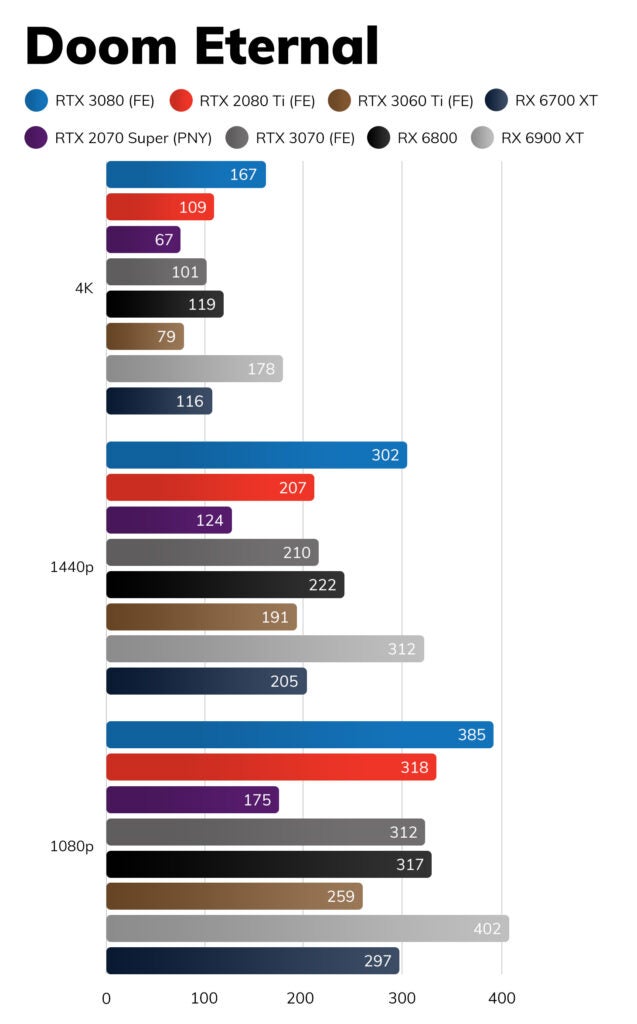
Doom Eternal
Doom Eternal is a fast-paced AAA first-person shooter. It doesn’t have ray tracing, but it’s one of the only games on the market that forces you to run it using the Vulkan API, not the more common Direct X, which will be important for specialist markets such as Linux gamers.
It doesn’t have a built-in benchmark, so we gauge performance by recording an average frame rate while running through the opening section of the first level. The RX 6700 delivered astoundingly fast post-100fps performance at every resolution.
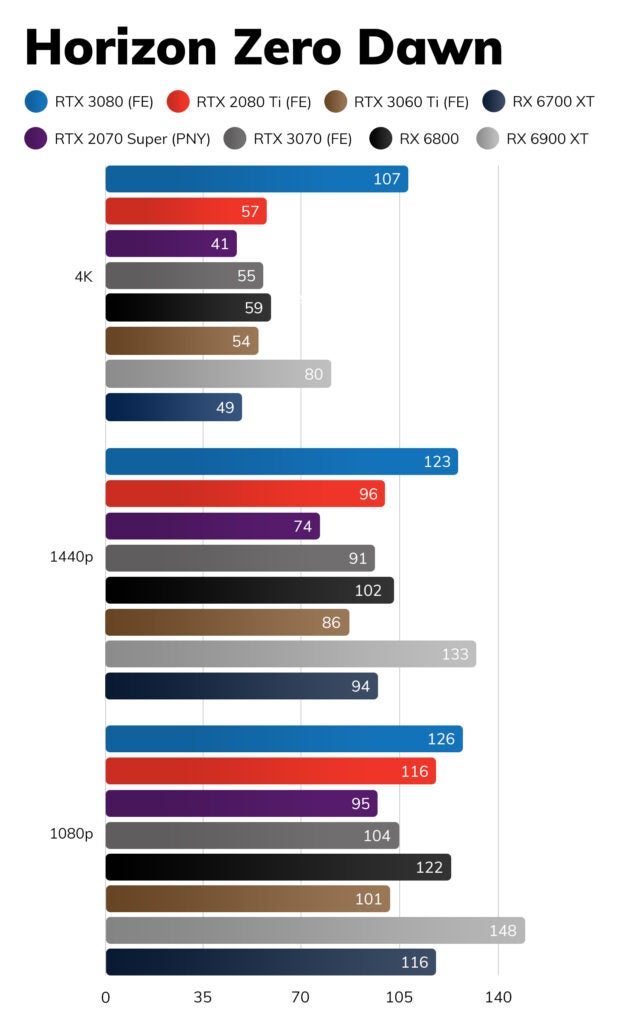
Horizon Zero Dawn
Horizon Zero Dawn is a super- demanding, but not terribly well-optimised, port of a former PS4 exclusive. It’s a beautiful game, full of complex open-world environments, advanced lighting effects and giant NPC enemies. Its internal benchmark is a good way to test how a GPU will deal with difficult-to-run AAA games. Here, the RX 6700 XT managed to deliver post-60fps speeds in 1440p and 1080p. It also ran the game in 4K at a playable 49fps speeds.
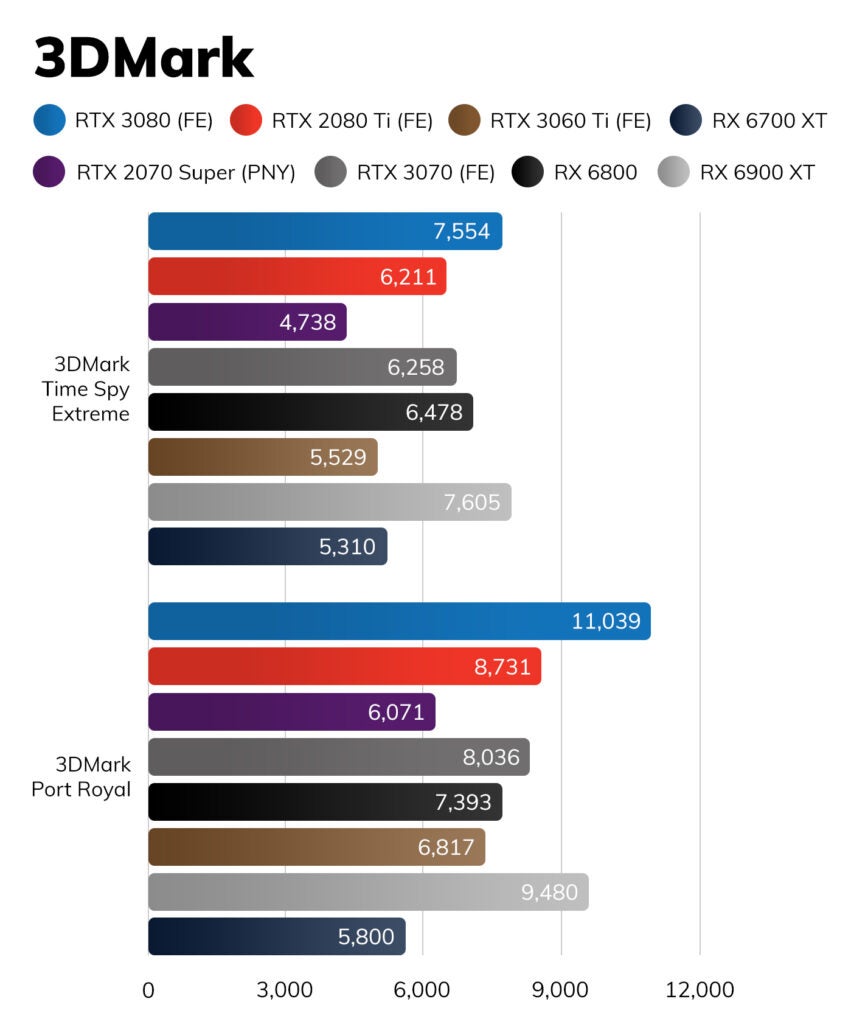
3DMark
3DMark is a suite of synthetic benchmarks designed to gauge various aspects of a PC’s graphical performance by tasking them to run a series of simulations. The Time Spy Extreme benchmark determines its Direct X 12 performance (the API used by most modern Windows games), while Port Royal aims to check how it will handle ray tracing. In both tests, a higher score is better.
We detected atypically low scores in both tests, which didn’t reflect our experience playing actual games. AMD told us this is likely due to the pre-release drivers we had to use during testing. We’ll update this review with the scores we get using the post release drivers once they become available.
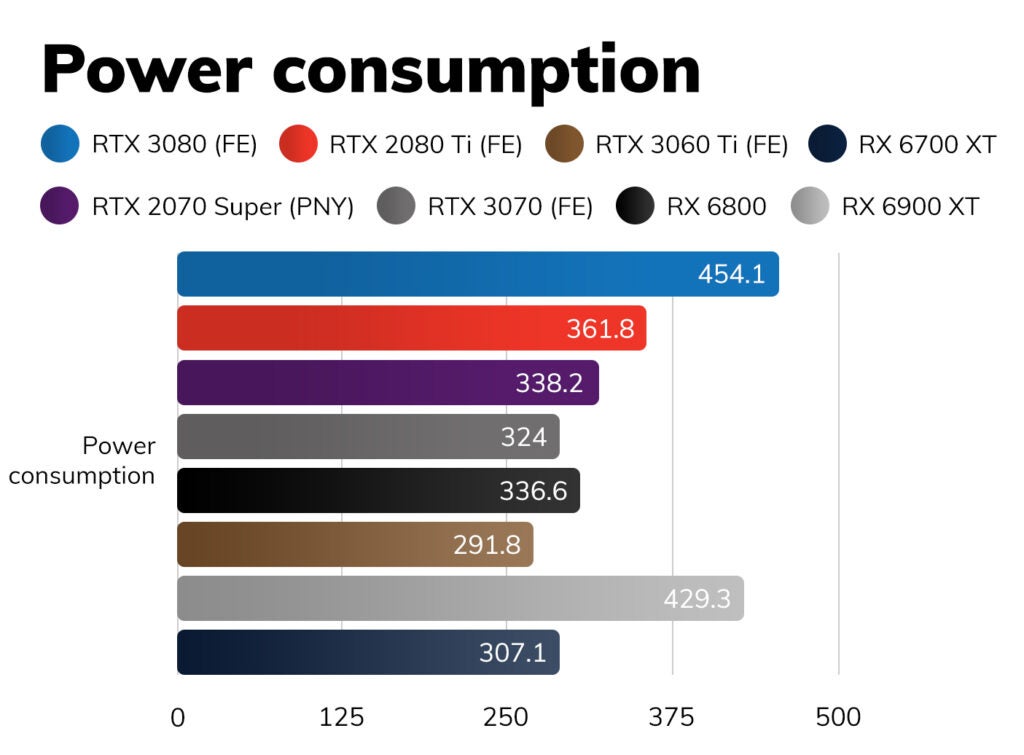
Power consumption, overclocking and heat
I detected a peak system power drawer of 307.1W while running Time Spy Extreme. This makes the RX 6700 XT the second-most power-efficient current-generation GPU I’ve tested currently. The only one to beat it here is Nvidia’s RTX 3060 Ti, which offered a 291.8W peak running the same test.
The AMD card also has a lead on its Nvidia rival when it comes to overclocking. This is a process used by hardcore games to boost a graphics cards’ speeds by tinkering with its settings in tools such as AMD’s Radeon software or MSI Afterburner. Doing a rough-and-ready overclock with Radeon software and testing it for stability using Time Spy’s stress test, I was able to get a stable 140MHz GPU clock speed and 30MHz VRAM overclock fairly quickly.
The card also runs reasonably cool, with my tests recording a 75ºC peak temperature while running Time Spy Extreme. The only card to run cooler during the same test from the current generation GPUs I’ve tested is the 3060 Ti.
AMD also lists it as offering a maximum operating temperature of 110ºC, thanks to its clever ability to measure “junction temperature”. Junction temperature is an alternative way to measure and manage heat, which focuses on the hottest part of the semiconductor, not the entire case.
AMD Radeon RX 6700 XT conclusion
The Radeon RX 6700 XT is a competent card that delivers excellent 1440p and 1080p performance in most instances. The only downside is that AMD’s ongoing lack of an Nvidia DLSS rival means it doesn’t fully deliver when playing games with ray tracing activated.
You should buy the AMD Radeon RX 6700 XT if…
- You want solid 1440p performance
The RX 6700 XT offered solid post-60fps performance in every test we threw at it with ray tracing turned off, making it a solid choice for gamers who aren’t too fussed about the feature.
- You’re planning a small build
The Radeon RX 6700’s low TDP and twin-fan design make it one of the only current-generation GPUs fit for mini-ATX builds.
You shouldn’t buy the AMD Radeon RX 6700 XT if…
- You want ray tracing
Without an answer to DLSS, the RX 6700 XT can’t match the ray tracing performance of the Nvidia RTX 3060 Ti, let alone its main rival, the RTX 3070. It’s difficult to recommend the card for this use case at the moment, as a result.


